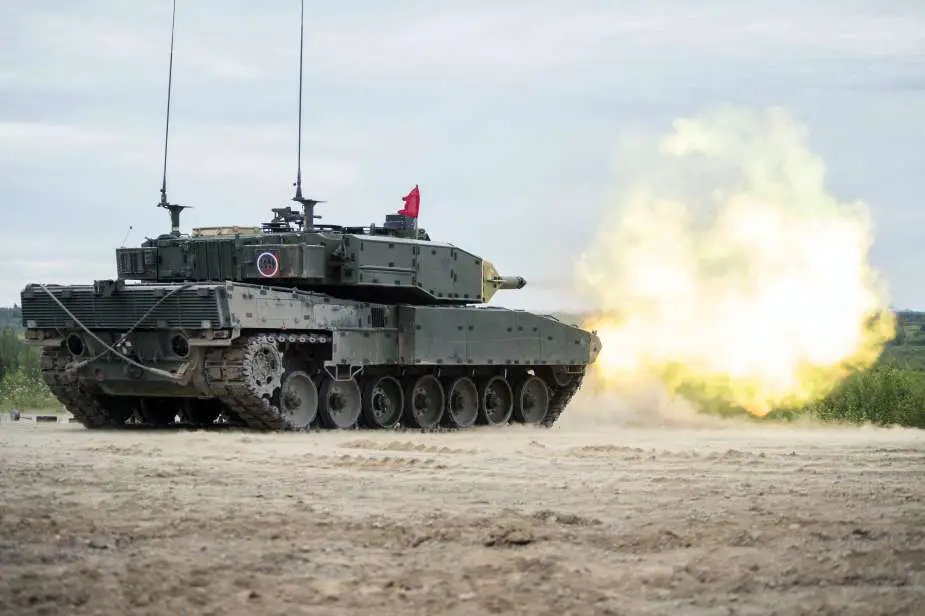Breaking news
Canada's Leopard 2 main battle tank fleet faces uncertain future.
As reported by Defense News on October 3, 2023, Canada is presently deploying 15 of its Leopard 2A4 tanks on an overseas mission for the first time in over a decade. Expected to arrive in Latvia in mid-November, this deployment is part of NATO's effort to reinforce its presence in Eastern Europe since the start of the war. However, the future of Canada's armored fleet remains uncertain, with questions arising on whether to maintain or replace aging tanks.
Follow Army Recognition on Google News at this link

A Canadian Leopard 2A4M during a live fire exercise in 2019 (Picture source: Canadian MoD)
The Canadian Army is actively working to determine the most suitable strategy for the upkeep and support of its aging tank fleet. This fleet comprises 82 Leopard 2 Main Battle Tanks (MBTs) currently in active service, as outlined in the Military Balance 2022 report: 42 Leopard 2A4, 20 Leopard 2A4M, and 20 Leopard 2A6M, with an additional 52 Leopard 1C2 held in military storage and not actively deployed. During Ukraine's conflict with Russia, Canada donated eight of its 2A4 tanks to Ukraine. A substantial financial commitment of approximately CA$ 1.5 billion (equivalent to US $1.1 billion) has been allocated for the establishment of a new long-term support contract specifically for the Leopard tank fleet.
This contract, expected to extend until the tanks' forecasted end of life in 2035, will encompass maintenance support, necessary upgrades, supply chain management, engineering support, and technical assistance, with the aim of ensuring the operational readiness of the Canadian Leopard 2 fleet.
Regarding the long-term support contract, the Canadian government has identified the German company Krauss-Maffei Wegmann as the sole-source provider. It is anticipated that a contract will be awarded by spring 2024, marking a significant step in ensuring the continued maintenance and readiness of the Leopard 2 fleet.
Beyond the long-term support contract, the Canadian Army is considering a plan to modernize its Leopard tank fleet. Army Lt. Col. Chloeann Summerfield has disclosed that this tank life extension initiative is estimated to cost more than CA$ 850 million (equivalent to US $ 618 million). Early plans for modernization prioritize enhancing various aspects of the Leopard 2, including protection, surveillance, target acquisition, firepower, and mobility. An intriguing aspect of this effort is the Army's intention to seek cooperation and a common configuration for these upgraded vehicles, promoting interoperability with other users of the Leopard platform.
A significant milestone in this project is the issuance of a request for bids from industry, expected around 2028. Subsequently, the first fielding of the upgraded tanks is anticipated to commence in 2030, marking a critical juncture in the tank fleet's modernization journey. One of the key considerations in determining the fate of the Canadian tank fleet is the "limited budget" mentioned by Lt. Col. Summerfield. Financial constraints are likely to exert substantial influence over Canada's decision on whether to acquire new tanks to replace the aging Leopard 2 fleet.
Canadian defense observers, including Martin Shadwick, a professor of Canadian defense policy at York University, have highlighted that the Canadian Army's history with tanks has been marked by policy shifts. In 2003, Lt. Gen. Rick Hillier announced the retirement of Leopard tanks in favor of the US-made Stryker Mobile Gun System. However, this decision was later reversed when Leopard tanks were deployed to Afghanistan in 2006 due to their superior protection against improvised explosive devices.
Following the conclusion of the Afghanistan war, Canadian tanks have primarily been utilized for training exercises within Canada. Despite the government's commitment to acquiring a limited number of new tanks to replace those donated to Ukraine, the acquisition plan has yet to progress since it was announced in February 2023. The office of the current defense minister, Bill Blair, has not provided specific details regarding the potential purchase of new tanks. Daniel Minden, Blair's press secretary, emphasized that capability requirements are currently under review by the Army, with plans and timelines yet to be determined.
However, experts like Alan Williams, a former defense procurement chief, have pointed out the considerable financial constraints facing the acquisition of new tanks. Major military purchases, including F-35 fighter jets and Canadian Surface Combatant ships, have already allocated a significant portion of the annual budget for defense equipment acquisitions, which is CA$ 5 billion (equivalent to US $ 3.6 billion). Furthermore, commitments to modernize North American Aerospace Defense Command and acquire P-8 patrol aircraft represent additional financial burdens. Given these prior commitments, it is unlikely that new tank acquisitions will take place in the near future.


























